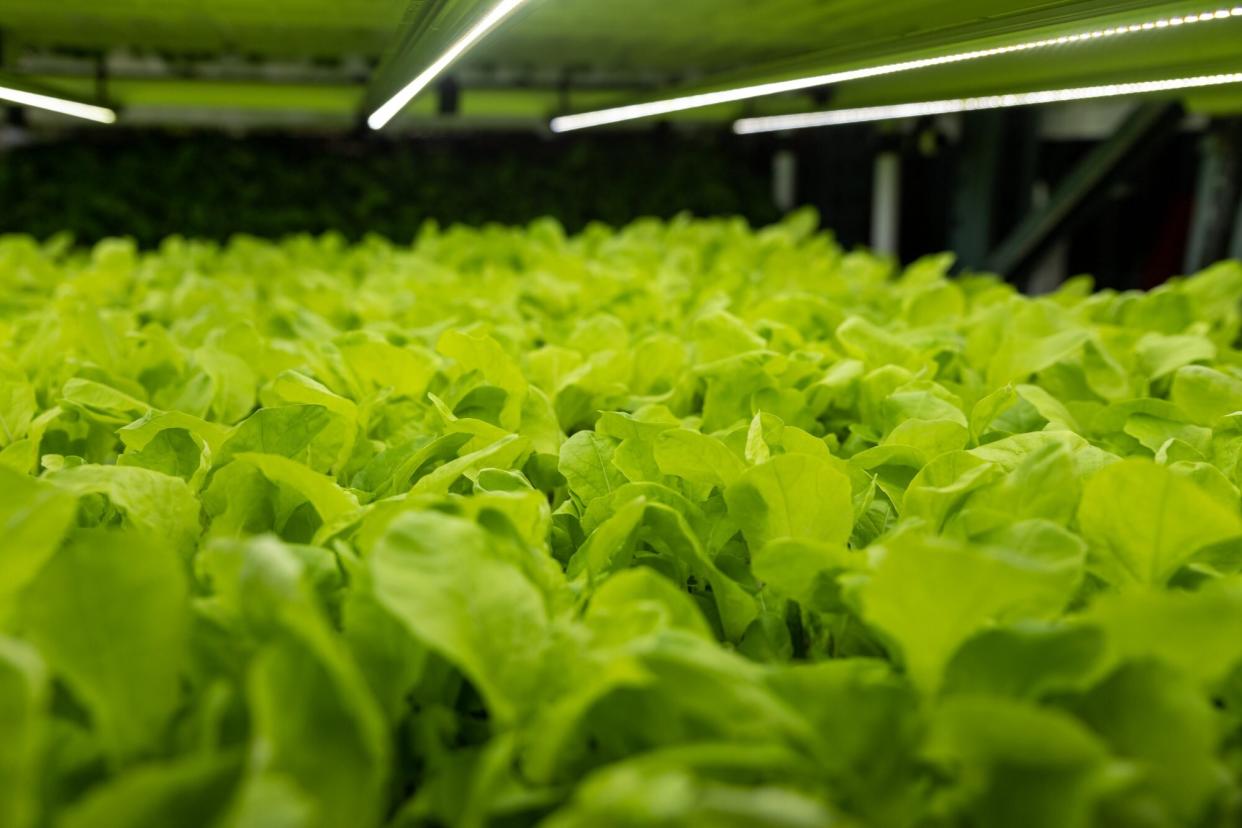Can Vertically-Grown Leafy Greens Make Your Salad Fresher and More Sustainable?

Courtesy of Forward Greens
A warehouse may seem like an odd place for a farm, but it's one of the places you'll find arugula, kale, and other leafy greens growing in Vancouver, Washington. The 25,000 square foot warehouse is home to Forward Greens, one of several indoor vertical farms attempting to use technology to make our lunch salads taste better and be better for the planet.
"We're trying to grow the cleanest healthiest greens we can while preserving the earth's resources," said Ken Kaneko, the founder of Forward Greens. Even if you haven't yet had greens from an indoor farm, chances are more and more of the greens in your salad are going to come from farms like Forward Greens, Gotham Greens, Bowery Farming, and others.
Related: Young Farmers Need Land and These Organizations Are Helping Them
What Exactly Is a Vertical Farm?
Simply put, it's a farm where rows of produce are stacked. "We grow up instead of out," Kaneko said. In the late 1990s and early 2000s, Columbia University professor and microbiologist Dickson Despommier and his graduate students began popularizing the idea of vertical indoor farms as one answer to some of the world's biggest problems: how to feed a growing worldwide population, especially with more and more people, centered around cities, and how to produce that food more efficiently and sustainably.
Today most indoor farms use soilless farming techniques. Some like, New York-based Gotham Greens, one of the early pioneers of indoor farms and whose products you'll find in Safeway, Meijer, and Harris Teeter, among others, use a hydroponics system. Other soilless systems include aeroponics and aquaponics.
Does Arugula Grown on an Indoor Farm Taste Better Than Arugula Grown Outside?
While outdoor farms rely on water, sun, and sometimes luck to produce leafy greens, most vertical indoor farms use technology and constant data monitoring to grow their crops. That data means that indoor farms can tweak everything from how your arugula tastes to how it feels to the nutrients it contains.
But beyond the tech, depending on where you live, leafy greens grown indoors might be fresher. Most of the salad greens you find in the supermarket likely came from Salinas, California, or Yuma, Arizona. According to Kaneko, Forward Greens delivers its products to markets in the Pacific Northwest within 48 hours of harvest. As vertical farms aren't dependent on weather, you can buy the same arugula from the same farm year-round. "We can provide a consistent year-round supply," said Gotham Greens CEO Viraj Puri. And that supply is also fully traceable, possibly making it safer.
Are Leafy Greens from an Indoor Farm More Sustainable?
As indoor farms can control everything from temperature to humidity to airflow and even lighting schedules, their products are often marketed as more sustainable than outdoor agriculture. According to Bowery Farming, whose leafy greens are available in the Mid-Atlantic and Northeast at Whole Foods Market, Giant Food, Stop & Shop, Walmart, and Weis Markets, their indoor farms are more "productive on the same footprint of land than traditional agriculture."
Similarly, Forward Greens says through its technology; it can use 95 percent less water, 99 percent less land, and 100 percent less pesticides compared to outdoor agriculture. But there's not much data on how vertical farms compare to their conventional counterparts. Researchers from Cornell University are in the middle of a three-year grant looking at not only how controlled-environment agriculture compares to traditional field agriculture in terms of energy, carbon and water footprints, profitability, workforce development, and scalability but what if any educational and psychological benefits local systems can offer by connecting urban people to their food. However, it's not clear if that study will also account for food waste, which has been found to be as high as one-third on traditional farms, and which both Puri and Kaneko say their farms can reduce.
While indoor farming likely isn't going to save the planet it may be one part of the puzzle and will make it easier to get fresh, locally grown salad greens year-round.

